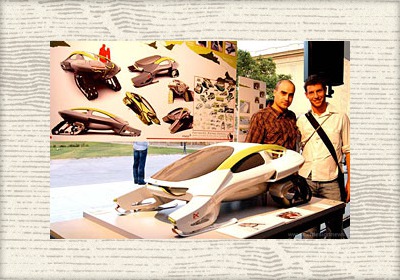College Exhibition: Elisava Design Degree Show 2004
Fri, 26 Nov 2004 Nov 26, 2004 - Graduating students from the Transportation Design Masters program at Spain's Elisava School of Design presented their work in the 2004 Degree Show entitled 'Mobility Techniques' held in July at the Mies van der Rohe Pavilion, in Barcelona.Go to Photo Gallery
120 photos
The projects shown are based on a wide vision of transportation design and take into consideration mobility, aerodynamics, environmental impact, ergonomics, legislation, materials, production, security, technology and aesthetic principles. They also aim to provide strategic solutions of design that can generate a new commercial and brand potential for industry.
Burton Malamute snow machine
Fernando Palma Banjul
The aim of this project is to provide a new type of snow vehicle. Its design allows the maximum use of the qualities of snow and frozen surfaces, irrespective of its thickness and texture. Burton Malamute is a two-seater vehicle that allows the incorporation of an extra seat in its cockpit for a third passenger. The vehicle is propelled by two rear-mounted caterpillar tracks. It is guided by two frontal skies as well as a snow jet, and a high capacity fuel tank and motor power provide it with a superior autonomy. This vehicle is designed as much for recreational use and extreme sports (comparable with a motorboat), as to tactical purposes such as people assistance or rescue in mountain areas.
Xtreme Mobility Concept
Joan Antoni Gil Fargas
Xtreme Mobility Concept is a two-seater recreational vehicle that combines the characteristics of a 4x4 with an aggressive sports design. The extreme sports look that characterizes the vehicle is based on a different way of understanding sportsmanship and the playful nature of a car. Its futuristic appearance is inspired by science fiction and bio-design. Its forms, as much undulating as angular, evoke the appearance of an exo-skeleton, and biomechanics is reflected in the vehicle configuration. Wheels are assembled on articulated arms that allow altering the height of the car according to the requirements of the terrain. Each arms contains an electric motor that allows independent control of the power transmission and traction of each wheel.
Loft-U
Raquel Aparicio L?pez
Increasingly, young vehicle users spend a lot of time inside vehicles, whether motivated by work or by leisure. For this reason, the automobile should stop being conceived only as a simple means of travel, to become a space of cohabitation between passengers. However, frequently only two passengers make use of these five-seater vehicles. The idea proposed by Loft-U is to make maximized use of the interior space by combining a functional with a more playful concept. It is a question of conceiving a wide space distributed in two areas: one to be used as a travel means, and the other either to leisure or rest purposes, in which users can feel 'at home'. This distribution is allocated to promote the relationship between passengers. Dimensions of this vehicle are similar to that of a minivan.
QuantumLeap
Marc Bieto
QuantumLeap owes its name to its conception as a vehicle with X-by-Wire and fuel cell power in 50 years time. This vehicle is designed for high speed travel outside city centres. Thanks to its space, modularity and versatility, the user is able to enjoy it as much as a sports car as a vehicle for weekend leisure. QuantumLeap is based on a concept as much rational as emotional. In this two contrasts come together: the bottom of an automobile, white coloured and with functional forms, and the part allocated to the space cockpit/dome, in red colour and with more aggressive forms. The project also reflects some of the most avant-garde features of industrial design, along with some referencess to futurist prototypes that were in fashion in the 1960's and 1970's.
Q2 Ambulance
Ana Borges and Guido Mannino
Q2 Ambulance is a concept that aims to introduce a new approach to design in a public service vehicle that at present is solved only with adaptations. Along with the specificity that its function requires, this project provides a personality of its own to this type of vehicle, as well as conveying the ideas of technology and innovation held inside, and allows a better and faster access to the equipment on board. Conceived to meet a new social necessity and to optimize the emergency service, Q2 Ambulance is able to transport two patients and to carry out medical operations in-situ thanks to the extensible module with which it is equipped. This is a vehicle that provides security, trust and dynamism.
Mitsubishi L-100
Miguel Gil Beltr?n
The Mitsubishi L-100 is a multi-purpose vehicle less than four metres long, developed from the platform of the Mitsubishi Colt. Designed to be used mainly in the city, it is also prepared for off-road use. With an interior configuration of 4+2 seats, as well as an extensible trunk, it provides space adaptation for the necessities of each situation. It is a vehicle to move nimbly through the city and also to go out to the country with the family at weekends. Inspired by little pet robots, it combines high technology solutions with a friendly and apparently simple aesthetic, a combination that promotes the use and interaction with users. Other features such as freedom, open space and a feeling of balance are the characteristics that have inspired this project.
Breeze
Miguel ?ngel Mena Roig
Breeze is a beach 'buggy' inspired in the anatomy of a crab, that has the ability to move nimbly across beaches. The vehicle is divided in two parts, united by a balland-socket joint that allows a better adaptability to the land. The chassis visibility is another of the characteristics that define this lighthearted, cheerful and dynamic vehicle.
By

